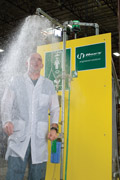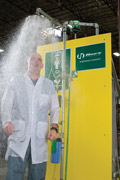
Hot or Cold? The Basics of Tempered Water
We hope emergency equipment systems are never used but must make certain they deliver the maximum volume needed, safely and adequately.
- By Casey Hayes
- May 01, 2010
 People's reaction to being hit with cold water has been used in comedy routines for many years. Providing it's not you being doused, it can be really funny. But cold water is no joke when used in emergency showers and eye/face washes. While a cold shower might be invigorating, it can be downright dangerous to run un-tempered or cold flushing fluid through industrial emergency equipment.
People's reaction to being hit with cold water has been used in comedy routines for many years. Providing it's not you being doused, it can be really funny. But cold water is no joke when used in emergency showers and eye/face washes. While a cold shower might be invigorating, it can be downright dangerous to run un-tempered or cold flushing fluid through industrial emergency equipment.
Emergency showers and eye/face washes minimize the effects of exposure to hazardous materials by drenching the affected areas of the body with signifi- cant amounts of water. This serves the dual purpose of removing any remaining hazardous material and minimizing further injury.
Through the years, the largest challenge faced by designers and specifying engineers has been providing ready access to emergency showers and eye/face washes. The basic design objective is to place emergency assets as close to potential accident sites as possible. This challenge becomes much more difficult in larger, more complex plants. More recent design configurations usually feature dispersed location of eye/ face washes and showers with centralized activation monitoring.
Another, more recent design challenge focuses on the effects of exposure to the high volumes of water used in eye/face washes and drench showers. Safety protocols call for at least 15 minutes of immediate and constant eye/face wash or shower use in response to exposure to hazardous materials. Exposure to domestic water temperatures in many areas of the country, when combined with the increased cooling effects of moving water passing over the body, can easily lead to hypothermia. Concern for worker safety has driven many companies to upgrade their emergency equipment to include tempered water. The use of "tepid" water easily allows for the full 15 minutes of eye/face wash or shower exposure required without risking hypothermia.
Recently, the International Safety Equipment Association revised the Z358.1 standard to include a delivered water temperature range of 60 degrees to 100 degrees F. This range is to protect the victim from hypothermia on the lower end and eye tissue damage on the higher end. At this time, there has not been a study to determine the proper delivery temperature for specifi c hazards. Until this study is done, manufacturers and specifiers have chosen 80 degrees F as a base point for delivery temperature. As with all installations, a medical advisor should be consulted to determine the optimum delivery temperature.
Tempered water blending systems generally consist of three major components: a hot water storage tank, a heater, and a blending valve. Additionally, a booster pump is oft en specified where water pressure might be too low to run multiple pieces of emergency equipment at peak demand. While the foregoing components define the additional items needed to upgrade an existing emergency equipment system to a tempered water system, opinions differ as to exactly what constitutes a complete system. Most emergency equipment manufacturers agree the specific requirements of the showers or eye/face washes that comprise the system need to be taken into account when sizing the components for the tempered water. That means the definition of the complete system includes both the tempering components and the specific emergency equipment in use or anticipated. An ANSI-compliant shower may not actually be compliant if the upstream tempering components are sized improperly. ANSI compliance is sought and granted based on specific pressure and flow ranges, which can be affected by tempering components placed in front of the otherwise compliant emergency equipment.
The heart of the tempered water delivery system is the mixing valve, which ensures the safety equipment safely receives water at the required temperature. Safety equipment manufacturers are in the best position to design appropriate mixing valves because we understand our equipment and our specific flow rate requirements. Knowing what flows and potential peak demands are expected is critical in properly designing a good system. For instance, consider a facility that has several pieces of safety equipment and needs tepid water delivered to all of them. First, we must determine how many of those devices may be required to run at once because the mixing valve must be capable of handling the highest demand of multiple uses, as well as the lower demand associated with a single eye/face wash. Determining flow requirements not only will help your safety equipment manufacturer to size the mixing valve properly, but also it will allow the manufacturer to determine the size of the required hot water source.
Once the mixing valve capacity has been established, you will need to know the associated pressure drop at the highest demand. The most common oversight is underestimating the pressure required to drive the safety equipment after it has passed through the mixing valve. The mixing valve can have a significant pressure drop because the flow requirement can be 30 gpm and higher. Also, safety equipment is designed so it will produce the required flow patterns at a minimum pressure of 30 psi. Adding this minimum pressure requirement to the pressure drop of the valve and the associated piping, you can determine what supply pressure is required. You might find there is insufficient pressure at the facility to run the system. If this is the case, you will have to add a booster pump to the supply or limit the number of showers and/or eye/face washes on the system. Other options are to look at increasing the pipe size one or two sizes so the friction losses are less. Furthermore, many safety equipment manufacturers offer components that will reduce the flow at the showerhead without sacrificing the required flow patterns.
Once you have the essential data to size the system, you need to ask the safety equipment manufacturer about the safety redundancies of its valve. This is very important. You need to ensure the mixing valve can offer a full flow bypass of cold water. In the event there is a loss of hot water at the valve or the cold-water inlet at the valve becomes restricted, it is essential there is a means to offer a full flow of cold water to the equipment. If you are considering a mixing valve stated to have an internal cold water bypass, you will need to ask whether this bypass can handle the maximum flow of the system design. If the bypass is less, there is a good possibility that an eye/face wash will not flow water if it is needed concurrently with a shower because the shower will take as much as it can receive. The offered mixing valve must also have a positive means of hot water shut-off in the event of a cold water failure. If there is a sudden loss of pressure on the cold side, the mixing valve must shut offcompletely and not allow any hot water to pass. You do not want a valve to pass only hot water because there may be enough flow to operate an eye/face wash. Temperatures in excess of 100 degrees F have been determined to be harmful to the eyes. These safety redundancies are essential to the safe operation of the mixing valve and should be external to the main mixing valve so their performance is not jeopardized by the overall performance of the mixing valve.
Final Considerations
Tempering water for emergency equipment requires more functionality than is built into most mixing valves. That's because most valves are individual valves, not valve systems, and they have been designed by valve manufacturers and not emergency equipment manufacturers, who know their equipment's requirements. Knowing the emergency equipment's operating requirements from the start allows us to see whether the tempered water system under consideration meets all of the necessary requirements.
Simply stated, there are two things to look for in a mixing valve system:
1. The mixing valve system must have a full flow bypass to compensate for hot water loss or thermostat failure.
2. The mixing valve system must provide for 100 percent hot water shut-offin the event of cold water supply failure.
In designing emergency equipment systems, we sincerely hope they are never used. But in the event that they are needed, we must make certain the systems will deliver the maximum volume needed, safely and adequately. There must also be safeguards and redundancies built into the system to maintain an acceptable minimum operation in the event of any possible failure or contingency.
This article originally appeared in the May 2010 issue of Occupational Health & Safety.